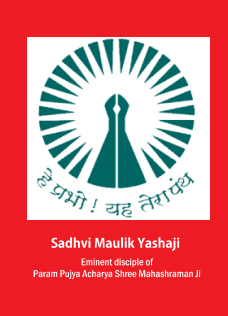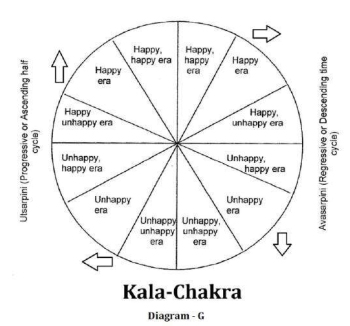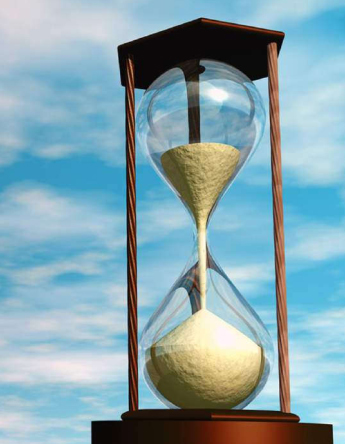 TIME
TIME
Jainism v/s Science
Time is one of the deepest mysteries known to man. No one can say exactly what it is. Yet, the ability to measure time makes humen way of life possible. Most of the activities involve groups of people acting together in the same place at the same time. People could not do this if they did not measure time in the same way. One way of thinking about time is to imagine a world without time.
This timeless world would be at a standstill; bf ut if some kind of change took place, that timeless world would be different'now'than it was 'before'. Thus, time and change are related because the passing of time depends on the change taking place. In real world, changes never stop happening.
Any change that takes place again and again stands out from other changes. The rising and setting of the sun is an example of this kind of change. Later, when man began to count repetitive natural events, he began to measure time by inventing the clock.
Sience
Time, a measure or measurable period, is a continuum that lacks spatial dimensions. Time, is of philosophical interest and is also the subject of mathematical and scientific investigation. According to Sir Issac Newton, who adopted an absolutist theory of time, stated that time is like a container within which the universe exists and change takes place. Time is believed to be non- ending, non-beginning, linear and continuous. Relationists explore the possibility that physics could showtime to have structure, it might consist of discrete particles (chronons), for instance, or it had been realized in the 20th century that time cannot be treated in isolation from space. Until recently, the rotation of the earth around its axis furnished the only time scale in general use i.e. the Solar Time.
Jainism
Time, as Umaswati stated, makes possible the continuity, modification, movement, newness and oldness of substances like space. Time is also inferred, though not perceived. It is inferred as the condition without which substances could not have the characters just mentioned, though it is true that time alone cannot cause a thing to have the characters. Without time a thing cannot endure or continue to exist. Modification or change of states also cannot be conceived without time. The distinction between the old and the new, the earlier and the later cannot be explained without time. The Jain philosopher postulates six Dravyas (substances) of which the five, namely Jiva, Dharma, Adharma, Akash and Pudgala are Astikaya and the sixth, namely Kala is not an extended body. Kala has no extension in space, because it is atomic in magnitude and it has neither pradeshas nor parts.

Classification and measurement
How do we tell time if there were no watches or clocks anywhere in the world?
Time is measured in many ways with the help of sun, tides, moon and stars. The sun was probably the world's first 'clock'. In most of the world, people have used the sun as a clock. Even today, if we don't have a regular clock that shows time, we still know that when the sun shines, it's day, and when its dark, its night. Not only the sun tells us whether it's day or night, but also whether its morning, noon or afternoon. Let us see how the time is measured with the help of the sun -
- When the sun is almost directly overhead, its noon.
- When the sun is halfway to this point, it's the middle of the morning.
- When it's half way down again, it's the middle of the afternoon.
Spirituality in Professional Life
Also we can notice that our shadow is the longest in the early morning and in the late afternoon. At noon, when the sun is overhead, there is little or no shadow. In this way, a long time ago, people noticed the way that shadow kept changing as the sun's place in the sky changed. They also made a sun clock, or a sundial.
When the sun shines on a sundial, a piece of metal sticking up on the sundial changes. The shadow touches different numbers in somewhat the same way as the hands of a clock point to numbers. It is almost as easy to read the time on sundial as it is on a clock.
Directly above every spot on the earth, an imaginary curved line called the celestial meridian passes through the sky. As the earth rotates on its axis, the sun crosses the celestial meridian above a particular place, the time there is noon. Twelve hours later, the time at that place is mid-night. The period from one midnight to the next is called a solar day. The length of a solar day varies because of the tilt of the earth's axis, the oval shape of its orbit, and its changing speed along the orbit.
How do people who live near the ocean, measure time? They tell time with the help of tides. In the day time, for about six hours, the water rises higher and higher on the beach and then it goes down and down for about six hours. The same thing happens again at night. There are two high tides and two low tides every 24 hours. Sailors on a ship learn how to tell time by looking at the moon and the stars. The whole sky is their clock. Another regular change in the sky was the change in the visible shape of the moon. Each cycle of the moon's changing shape takes about 291/2 days, for a month. Astronomers also measure time by the earth's rotation in relation to the stars. This time is called sidereal time. Each day, as the earth rotates on its axis, an imaginary point among the stars called their vernal equinox crosses the celestial meridian above every place on the earth. The time when this happens is sidereal noon.
According to Jainism, time is infinite by itself and consists of innumerable parts which are indivisible instants (samaya). Samaya, being the smallest indivisible quantum of time, can perhaps be appropriately called time-points. Although immeasurably small and numerically inexpressible, it is a finite unit.
The relative time relates to the motion of the sun and the moon. The suns and the moons always revolve round the Mt. Meru in the samayakshetra. Beyond that, though existent, they are stationary and, therefore, time exists only in the samayakshetra.
Classification of time as per Routine & Jain Calender:
Time classification-Routine Calendar:
| 60 Sec = 1 Minute | 3 Month = 1 Season |
60 Minute = 1 Hour | 4 Season = 1Year |
24 Hours = 1 Day | 10 Years = 1 Decade |
30 Days = 1 Month | 10 Decades = 1 Century |
Timeclassification-Jaincalendar:
| Minimum self-raised time unit = 1 samaya |
Minimum self-raised Innumerable time units = 1 avalika |
Division of timer:
There are two divisions of time - linear and cyclic
Linear Time:
ln linear time comes B.C. and A.D.
B.C. stands for Before Christ.
In A.D. 532, a monk named Dionysius Exigeues, worked out a Christian system for dating events starting with the year he believed Christ was born. He called this year after their event Anno Domini (in the year of our lord), as A.D. 532. The years before the birth of Christ are Before Christ, as in 400 B.C. To date an event before the birth of Christ, we count backward until 1.
Cyclic Time:
According to Jain philosophy, this universe has been mobile since time immemorial. It has got no beginning and no end. From the point of view of objector matter, it is universal and unchangeable. But from the point of view of mode, it is changing every moment. It can neither be created nor destroyed.
The cycle of time has also been going since time immemorial. The beginning and the end cannot be possible in the constantly moving cycle. The cycle of time, therefore, is indivisible and unbreakable. But for practical use, we make divisions of time. In Jain philosophy, time has been compared to a wheel.
Just as there are 12 spikes in a wheel, similarly, there are 12 spikes in the cycle of time as well and they have been divided into two parts, which are known as Avasarpini (Regressive Half Cycle) and Utsarpini (Progressive Half Cycle).
| Sushma - Sushma | Happy Happy Era |
| Sushma | Happy Era |
| Sushma - Dushma | Happy Unhappy Era |
| Dushma - Sushma | Unhappy Happy Era |
| Dushma | Unhappy Era |
| Dushma - Dushma | Unhappy Unhappy Era |

The Classification is done as under:
| Name of the Ara | Degree of happiness | Duration of Ara | Average Height of People | Average Lifespan of People |
Susama- susamā | Utmost happiness and no sorrow | 400 trillion sāgaropamas | Six Miles Tall | Three |
Susamā | Moderate happiness and no sorrow | 300 trillion sāgaropamas | Four Miles Tall | Two |
Susama- duhsamā | Happiness with little sorrow | 200 trillion sāgaropamas | Two | One |
Duhsama- susamā | Sorrow with little | 100 trillion sāgaropamas (less 42,000 years) | 1500 Meters | 705.6 |
Duhsamā | Sorrow | 21,000 Years | 6 Feet | 130 Years Maximum |
Duhsama- duhsamā | Extreme sorrow and misery | 21,000 Years | 1 Hatha | 16-20 Years |
In Digamber tradition, time is distinguished from two standpoints - conventional (Vyavahara) and real (Paramartha). The conventional is the time which helps to determine changes in a substance and which is known from modifications produced in it, while real time is considered from continuity.
According to Shvetamber tradition, it is the change of an object which takes place every moment and therefore it is not considered different from the living and non-living entities. But Digamber tradition explains it differently and therefore regards it as an independent reality. Accordingly, it is time element due to which change in an object takes place.
The Digamber tradition holds that the real time consists of innumerable units of time, technically known as Kalanu i.e. atom of time that never mixes up with each other. The universe is full of these units of time. No space- point of the universe is devoid of it.

Conclusion
Really speaking, time is nothing but the auxiliary cause of change. This change is understood in relation to continuity. Without continuity change cannot be understood at all. Hence, continuity is the ground of change. From ordinary point of view, time is understood in seconds, minutes, hours etc.; the factors by which we call a thing to be new or old according to changes produced in the same.
“The clock arms follow the discipline, thus people trust them; similarly if you respect discipline, the trustworthiness will automatically increase.”
- Acharya Mahaprajna.
 Sadhvi Maulik Yasha
Sadhvi Maulik Yasha
